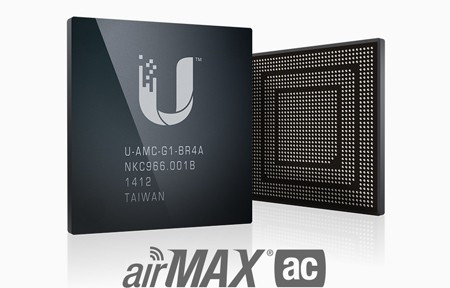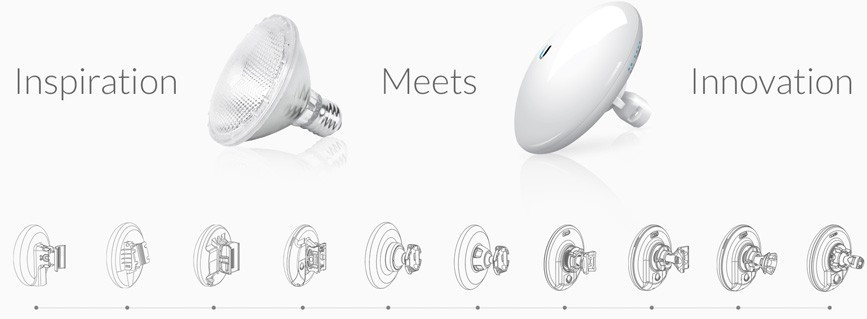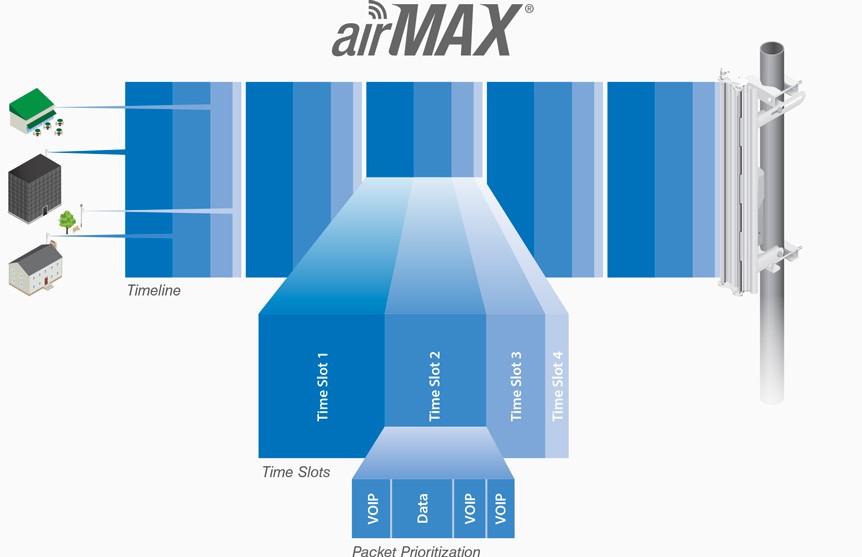The airMAX NanoBeam M5 is a compact, wireless broadband solution from Ubiquiti Networks, designed to offer a significant advancement in the realm of efficient and reliable long-distance communication. This device is part of Ubiquiti's airMAX series, which is known for pioneering outdoor wireless networking by integrating innovative technology with user-friendly features to cater to a broad spectrum of applications, from internet service providers (ISPs) looking to expand their networks to businesses and individuals seeking to establish point-to-point (PtP) connections.

The NanoBeam M5 is explicitly compatible with other airMAX devices, allowing for harmonious operation in both point-to-point (PtP) and point-to-multipoint (PtMP) network configurations. This includes seamless interaction with airMAX sector antennas, base stations, and other CPE devices, facilitating the establishment of robust, high-speed wireless networks. Moreover, NanoBeam M5 operates in the 5 GHz band using airMAX technology. For optimal performance, it should be paired with devices that support the same frequency and technology. Mixing devices from different bands (e.g., 2.4 GHz) or technology standards without consideration can lead to compatibility issues or reduced network performance.
In addition, please keep in mind that NanoBeam M5 does not natively integrate with Ubiquiti's UniFi series. While Ubiquiti's UniFi series is designed for managed Wi-Fi networks, primarily targeting indoor and semi-outdoor deployments, the airMAX series, including the NanoBeam M5, is optimized for outdoor, long-distance wireless links. The two product lines operate on different management platforms (UniFi Controller for UniFi devices and airOS for airMAX devices), limiting direct interoperability.
Central to the NanoBeam M5's design is its use of the 5 GHz frequency band, which is less crowded than the 2.4 GHz band, providing cleaner air space for transmission and thus reducing interference from other wireless signals. This choice of frequency, coupled with Ubiquiti's proprietary airMAX technology, allows the NanoBeam M5 to deliver unparalleled performance in terms of throughput and signal quality over considerable distances.

The NBE-M5-16 model comes equipped with a 16dBi high-gain antenna, which is integrated into the device to create a powerful all-in-one unit. This highly directional antenna focuses the radio's power into a tighter beamwidth, greatly enhancing the device's ability to target distant receivers with precision. Such directivity ensures that the signal is strong and stable, even over long distances, making it highly efficient for establishing wireless connections that require minimal interference and high-speed data transfer.

Ubiquiti’s airMAX® technology is proven in millions of deployments worldwide, exhibiting outstanding performance in outdoor environments. The TDMA airMAX protocol with custom IC dramatically enables unprecedented scalability, high throughput and low latency in unlicensed, multipoint networks. While custom silicon provides hardware acceleration capabilities to the airMAX scheduler, to support the high data rates and dense modulation used in airMAX ac technology.
Ease of installation is another key attribute of the NanoBeam M5. The device incorporates a unique ball joint mount that provides flexible alignment options, allowing for precise aiming to achieve the optimal signal strength and link stability. This mounting mechanism, together with the device's compact form factor, enables quick and straightforward installation on a variety of structures, including poles and walls, without requiring specialized tools or extensive labor.
Built with durability and resilience in mind, the NanoBeam M5 features a robust, weather-resistant design. Its protective casing shields the internal components from harsh environmental elements such as rain, dust, and extreme temperatures(-40 °C to 70 °C), ensuring reliable operation in diverse outdoor settings. This makes the device particularly well-suited for deployment in challenging geographical locations where traditional wired connectivity solutions are impractical or too costly to implement.
On the software side, the NanoBeam M5 runs on Ubiquiti's advanced airOS firmware, providing users with a highly intuitive user interface for device configuration and network management. airOS offers a comprehensive suite of features, including detailed statistical reporting, advanced RF analytics, and real-time device status monitoring. These features empower network administrators and users to fine-tune their network settings for maximum performance, ensuring optimal utilization of the wireless spectrum.
Moreover, the NanoBeam M5 supports Power over Ethernet (PoE), simplifying the deployment process by allowing both power and data to be delivered over a single Ethernet cable. This PoE capability reduces cable clutter and eliminates the need for separate power sources, further enhancing the device's ease of installation and flexibility in positioning.
The airMAX NanoBeam M5 from Ubiquiti Networks is adept at addressing a wide range of wireless connectivity needs. It's ideal for connecting two distant locations, the NanoBeam M5 excels in creating high-speed, reliable PtP links. Whether it's connecting two buildings within a corporate campus, linking remote offices to the main network infrastructure, or extending internet access to a remote home or facility, this device ensures efficient, high-bandwidth connectivity over kilometers. While, in scenarios where a single internet source needs to be distributed to multiple locations, the NanoBeam M5 serves as an effective CPE (Customer Premises Equipment). ISPs can deploy these units to deliver broadband services to residential or business customers spread over a wide area, ensuring consistent, high-quality internet access. Wireless ISP (WISP) Infrastructure can truly benefit from leveraging the NanoBeam M5 to expand their service coverage or enhance network capacity.
For surveillance networks that span large areas, such as industrial complexes, parking lots, or public parks, the NanoBeam M5 can provide the necessary backhaul links. It supports the high data rates required for transmitting high-definition video feeds from surveillance cameras back to a central monitoring location, maintaining the integrity and quality of the video data. Meanwhile, for temporary events like festivals, outdoor concerts, or sports competitions, the NanoBeam M5 can quickly establish wireless links to provide internet access or connect various operational areas.
In each of these scenarios, the airMAX NanoBeam M5 (NBE-M5-16) from Ubiquiti Networks exemplifies cutting-edge wireless networking technology, offering a powerful, efficient, and reliable solution for long-distance communication. With its high-gain directional antenna, robust design, and advanced networking features, the NanoBeam M5 stands out as an ideal choice for a wide range of applications, including but not limited to, connecting remote locations, expanding network coverage, and facilitating high-speed data transmission across extended distances.
Compare with similar products
| | | | |
|---|
| Wireless Standard | |
| |
| 802.11a/n
| 802.11ac
| 802.11ac
|
| 2.4GHz Radio Rate | |
| |
|
| 300 Mbps
|
| 5GHz Radio Rate | |
| |
| 150 Mbps
| 450 Mbps
|
|
| Wireless Antenna Frequency Range & Gain | |
| |
| 5.150 - 5.875 (GHz) 16 (dBi)
| 5.150 - 5.875 (GHz) 19 (dBi)
| 2.412 - 2.472 (GHz) 13 (dBi)
|
| Ethernet Ports | |
| |
| 1 x 100 Mbps
| 2 x 1 Gbps
| 1 x 1 Gbps
|
| Chipset | |
| |
| Atheros MIPS 74Kc, 560 MHz
| Atheros MIPS 74Kc, 720 MHz
| Atheros MIPS 74Kc, 533 MHz
|
| RAM | |
| |
| 64 MB
| 128 MB
| 64 MB
|
| Storage Memory | |
| |
| 8 MB
| 8 MB
|
|
| Operating Temperature | |
| |
| -40 °C to 70 °C
| -40 °C to 80 °C
| -40 °C to 70 °C
|
| Max Power Consumption | |
| |
| 6 W
| 8.5 W
| 7.5W
|
| Weight | |
| |
| 0.320 kg
| 0.530 kg
| 0.530 kg
|
| | | | |
|---|
| Wireless Standard | 802.11a/n
| 802.11ac
| 802.11ac
|
| 2.4GHz Radio Rate |
|
| 300 Mbps
|
| 5GHz Radio Rate | 150 Mbps
| 450 Mbps
|
|
| Wireless Antenna Frequency Range & Gain | 5.150 - 5.875 (GHz) 16 (dBi)
| 5.150 - 5.875 (GHz) 19 (dBi)
| 2.412 - 2.472 (GHz) 13 (dBi)
|
| Ethernet Ports | 1 x 100 Mbps
| 2 x 1 Gbps
| 1 x 1 Gbps
|
| Chipset | Atheros MIPS 74Kc, 560 MHz
| Atheros MIPS 74Kc, 720 MHz
| Atheros MIPS 74Kc, 533 MHz
|
| RAM | 64 MB
| 128 MB
| 64 MB
|
| Storage Memory | 8 MB
| 8 MB
|
|
| Operating Temperature | -40 °C to 70 °C
| -40 °C to 80 °C
| -40 °C to 70 °C
|
| Max Power Consumption | 6 W
| 8.5 W
| 7.5W
|
| Weight | 0.320 kg
| 0.530 kg
| 0.530 kg
|
Technical Specs / Datasheet





Reviews and ratings
Product rating